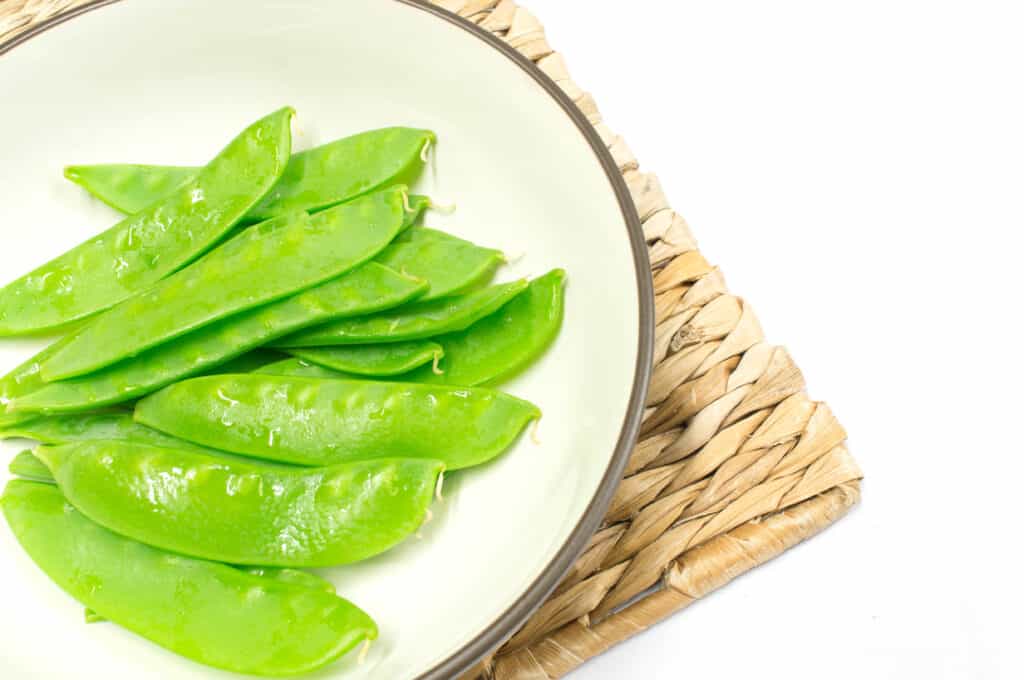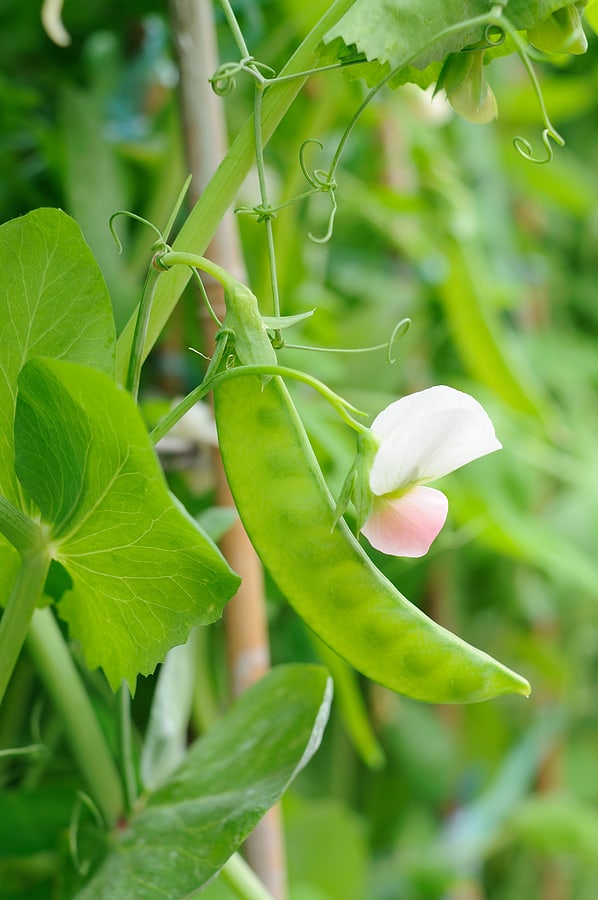Snow peas are edible-podded peas: you eat the seed and pod whole.
You can use snow peas in the same way as fresh peas or green beans. In fact, snow peas and green beans are interchangeable in most recipes.

.
The peak season for snow peas is spring and then again in fall.
How to choose snow peas
- Select snow peas that have crisp, brightly colored pods with small seeds.
- Snow peas should have flat pods with barely developed seeds and be about 3 inches (7.5 cm) long. If you see vestiges of a petal at the stem end, you know it’s fresh.
- Snow peas with swollen pods or that are too big will be tough and inedible.
- Avoid peas with yellow spots or signs of drying along the seams.
- Avoid pods that appear soft or wrinkled.
How to store snow peas
- Snow peas can be refrigerated in a plastic bag for up to 3 days. The longer you keep them, the less crisp and sweet they will become.
How to prepare snow peas
- Snap off the stem end of the pea just before cooking and pull the string along the side.
- Young snow peas can be eaten raw.

Snow pea serving suggestions
- Serve snow peas raw or cooked. Use snow peas as a side dish for meats or fish or in salads.
- Sauté in oil in a skillet or stir-fry snow peas in oil by themselves until hot throughout about 1 or 2 minutes.
- Snow peas can be eaten raw in salads and appetizers. They are sweet and crisp.
- A great spring salad: toss blanched snow peas with sugar snap peas, young beans, and asparagus.
- But snow peas are even sweeter cooked. They are a favorite in oriental-style soups and wok-tossed dishes. Their sweet texture is a perfect foil for Asian cookery accents such as ginger, garlic, chili, and soy sauce.
- Snow peas have translucent, bright green pods that are thin and crisp. The seeds are tender and sweet and the pods are crunchy. The combination of tender, sweet, and crunchy is what makes snow peas special.
Snow pea cooking suggestions
- Cook snow peas briefly: steam, simmer, or stir-fry for 1 to 2 minutes—test for tender crunchiness; boil about 1½ minutes; simmer in the soup for 1 minute; oven steam sealed in parchment or foil 5 to 6 minutes.
- Brief cooking of snow peas even when used for cold dishes will develop sweetness, flavor, and color. Overcooked snow peas will be mushy.
- Add snow peas to soups or stews.
- Parboil in salted water—not more than one minute, drain, and toss with butter or dribble with extra-virgin olive oil, then season with salt and pepper, and toss with chopped herbs: basil, parsley, or chervil.
- To use snow peas chilled, do not string them before but after cooking.

How to sauté snow peas
- Break or cut the stem ends off the snow peas and remove the strings.
- Fill a medium saucepan of lightly salted water to a boil over high heat.
- Add the snow peas and bring the water back to a boil.
- Boil the peas briefly, just 30 to 45 seconds.
- Drain the peas in a colander.
- Add 2 tablespoons of butter to the pan and set it over medium heat.
- When the butter begins to bubble, add the drained snow peas.
- Sauté the pea pods in the butter, stirring, for about 1 minute.
- Add a squeeze or two of lemon and continue cooking for 1 minute.
- Season to taste with salt and freshly ground black pepper.

How to steam snow peas
- Break or cut the stem ends off the snow peas and remove the strings and wash
- Place an inch of water into a saucepan. Put a steamer basket over the water; be sure the water does not touch the basket.
- Put the snow peas in the basket.
- Bring the water to a boil, then cover the pot.
- Cook until the peas are tender and bright green, about 2 minutes. Do not overcook.

How to stir-fry snow peas
- Break or cut the stem ends off the snow peas and remove the strings and wash.
- Place 2 tablespoons of peanut or canola oil in a large deep skillet or wok and turn the heat to high.
- When the oil begins to smoke put the snow peas in and cook, stirring frequently.
- Snow peas will be cooked when they turn glossy and bright green and have a few seared brown spots, for about 5 minutes.
- Turn off the heat and use a slotted spoon to place the peas on a serving dish.
- Drizzle with soy sauce and sesame oil.
Snow peas flavor partners
- Some other herbs and flavor additions that complement pea pods nicely are mushrooms, peanuts, ginger, garlic, parsley, basil, and chervil.
- To add some garlic flavor, peel 1 clove of garlic and cut in half. Saute the garlic pieces in the butter for 1 minute. Remove the garlic and discard; add the snow peas to the butter. Saute for about 1 minute. Add the lemon zest and almonds, if using; continue cooking for 1 minute. Season the pea pods with salt and freshly ground black pepper as desired.

About snow peas
- Snow peas are thought to be an Asian vegetable. That’s because today they are essential to Chinese cooking. Snow peas are the main pea eaten in China and Japan.
- But snow peas were first cultivated in Holland. (Peas originated in Persia—modern-day Iran—more than 12,000 years ago.) The snow pea was developed by Dutch farmers in 1536. The Dutch love developing new tender, sweet peas.
- From Holland, snow peas—which were then known as Dutch peas—traveled to England and from England traders introduced snow peas to China. The Chinese name for snow pea is hoh laan dau which means Holland pea.
- The snow pea became so popular in China that it was soon called the Chinese pea.
- Here’s an even more interesting twist: the Chinese snow pea did not get the name snow pea in China. Immigrant Cantonese farmers in San Francisco during the nineteenth century called the Chinese pea shii dau—snow pea. No one is sure why.
The botanical name of snow peas is Pisum staivum var. marcrocarpon.
Peas rlated articles on Harvest to Table:
How to Cook and Serve Garden and Snap Peas
How to Prepare Spring Peas with No Recipe
English Peas, Spring Onions, and Roasted Almonds
Baby Beets, Baby Carrots, and Sugar Snap Peas Salad
How to Cook and Serve Snow Peas
Garden Planning Books at Amazon:
- Tomato Grower’s Answer Book
- Vegetable Garden Almanac & Planner
- Kitchen Garden Grower’s Guide Vegetable Encyclopedia
- Vegetable Garden Grower’s Guide
More kitchen tips:
Bring your harvest to the table. Kitchen prep tips and easy recipes for the vegetables you grow. Click below for vegetable prep and recipes you can use now.
- Almonds
- Apples
- Apricot
- Aprium
- Artichoke
- Arugula
- Asparagus
- Avocado
- Bamboo Shoots
- Banana
- Basil
- Beans, Dried
- Beans. Long
- Beans, Shell
- Beans, Snap
- Beets
- Bitter Melon
- Blackberry
- Bok Choy
- Broccoli
- Broccoli Raab
- Brussels Sprouts
- Cabbage
- Cardoon
- Carrots
- Cauliflower
- Celeriac
- Celery
- Chard
- Chayote Squash
- Cherimoya
- Cherries
- Chestnut
- Chickpea
- Chinese Cabbage
- Chives
- Cilantro
- Citron
- Clementine
- Collards
- Coriander
- Corn, Sweet
- Corn, Baby
- Corn Salad, Mache
- Cranberry
- Cress
- Cucumber
- Daikon
- Dandelion
- Dill
- Eggplant
- Endive, Belgian
- Endive and Escarole
- Fava Beans
- Fig
- Florence Fennel
- Garlic
- Ginger
- Grapefruit
- Grapes
- Guava
- Horseradish
- Jerusalem Artichoke
- Jicama
- Jujube
- Kale
- Kiwifruit
- Kohlrabi
- Kumquat
- Leeks
- Lemongrass
- Lemons
- Lettuce
- Lime
- Mache (Corn Salad)
- Mandarin Orange
- Mango
- Maple Syrup
- Marjoram
- Melons
- Michihili
- Mint
- Mizuna
- Mushrooms
- Mushrooms, Cremini
- Mustard Greens
- Napa Cabbage
- Nectarine
- Okra
- Olives
- Olive oil
- Onions
- Oranges
- Oregano
- Parsley
- Parsley Root
- Parsnips
- Passion Fruit
- Pawpaw
- Peaches
- Pears
- Peas, Garden Snap
- Peas, Snow
- Pei Tsai
- Peppers, Chili
- Peppers, Sweet
- Persimmon
- Pineapple
- Pineapple Guava
- Plantain
- Plums
- Pluots
- Pomegranate
- Potatoes
- Prickly Pear
- Pumpkin
- Quince
- Radicchio
- Radishes
- Raspberries
- Rosemary
- Rhubarb
- Rutabaga
- Sage
- Salsify
- Sauerkraut
- Savory
- Shallots
- Sorrel
- Spinach
- Squash, Summer
- Squash, Winter
- Strawberries
- Sunchokes
- Sunflower
- Sweet Potato
- Swiss Chard
- Tangerine
- Taro
- Tarragon
- Thyme
- Tomatillo
- Tomato
- Turnip
- Turnip Greens
- Yams



